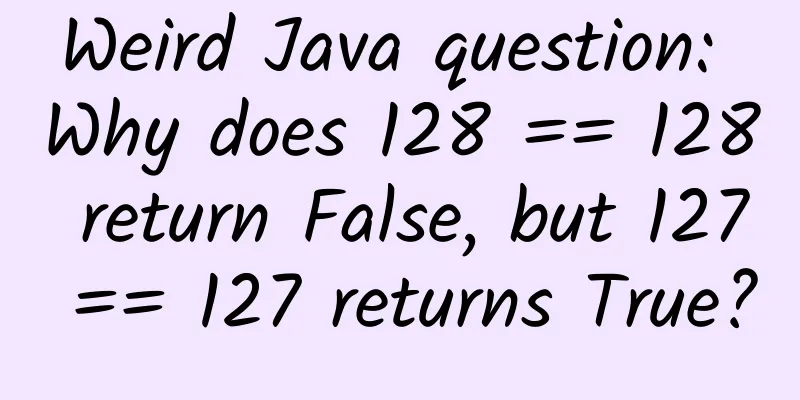Weird Java question: Why does 128 == 128 return False, but 127 == 127 returns True?

|
This is the topic we are going to discuss today because I think it is very interesting. If you run the following code:
You will get the following result:
We know that if two references point to the same object, then == is true; conversely, if the two references do not point to the same object, then == is not true, even if the contents of the two references are the same. Therefore, the result will be false. This is where it gets really interesting. If you look inside the Integer.java class, you’ll find an inner private class called IntegerCache.java that provides a cache for all integer objects between -128 and 127. This thing provides an internal cache for small integers, and when declared like this:
This is what it looks like inside:
In fact, after I decompile the A.class file, the code is as follows: If we look at the valueOf() class function, we can see:
If the value is between -128 and 127, it returns an instance of that cache. therefore...
Both refer to the same object. That's why the following code evaluates to true:
Now you might ask, why would there be a cache for all integers between -128 and 127? This is because the frequency of use of small integers in this range is much greater than that of other integers in daily life, and the fact that the same underlying object is used multiple times can be effectively optimized for memory through this setting. You can use this feature arbitrarily using the reflection API. Run the following code and you will see the magic.
The print result is:
Let's look at the disassembled code again: Is this the same problem as above? But why is the result 2 + 2 = 5? Let's continue to look at the Integer source code to gain a deeper understanding of the Integer cache mechanism. Here is a screenshot: According to the source code, we can find that the method of modifying the upper limit of the Integer cache has some minor flaws. Let's take a look at what the API suggests to us:
It turns out that we only need to set -XX:AutoBoxCacheMax=133 at runtime. |
<<: Android performance optimization memory leak
>>: How to use fastboot to flash the original image to Android
Recommend
How to increase the number of public account readers? Just read this article
Can you tell the difference between the final tit...
The 2022 Central Inspection List is here! Which specific units will be inspected?
In recent years, the central government has arran...
OTT advertising: Compared with scale, we should pay more attention to the rise of living room consumption scenarios
As an emerging advertising channel, the scale of ...
Is the stone mountain that Calabash Brothers transformed into sedimentary rock, igneous rock or metamorphic rock?
Interesting brain teaser! My imagination is limit...
How does the points mall operate? These 4 stages are very important!
When I first came into contact with the Points Ma...
In-depth | Talk about the operational strategy of AARRR model in e-commerce marketing activities
The " AARRR Model " is a concept mentio...
In the past two years, operators should force themselves to learn some Douyin
Many entrepreneurs and operation practitioners ha...
Is the phone lagging related to the processor or the memory? I finally figured it out today
It is well known that mobile phones will start to...
The pain is no less than giving birth! It is recommended that people over 50 years old do this as soon as possible...
This article was reviewed by Wang Ruiyan, MD, ass...
Do you still remember China’s “best tasting vaccine”?
On March 26, 1953, the first polio vaccine was su...
Su Nannan's 10,000 Words Class: Memorizing 10,000 Words is So Easy
Su Nannan's 10,000 Words Class: Memorizing 10...
Verification code countdown
Source code introduction Verification code relate...
Guardian of the desert salt land: Tamarix, you must have been here for a long time
In the vast Gobi Desert of the northwest, there i...
A method for batch creation of short videos with high conversion rate and selling products on Douyin!
1. Short video creation logic of live streaming m...
Xiaohongshu community operation strategy!
Did you think Xiaohongshu was a gathering place f...









